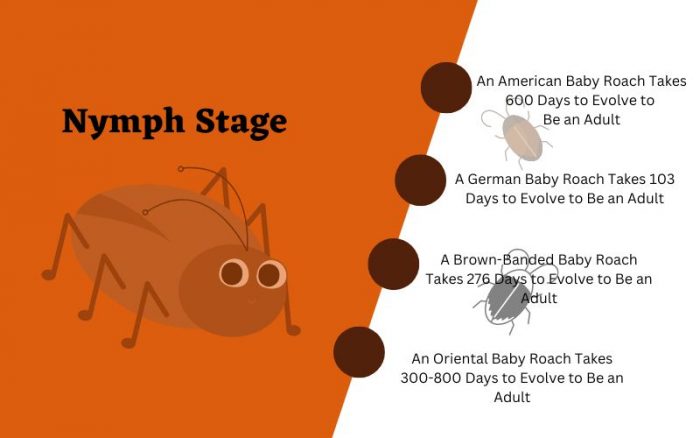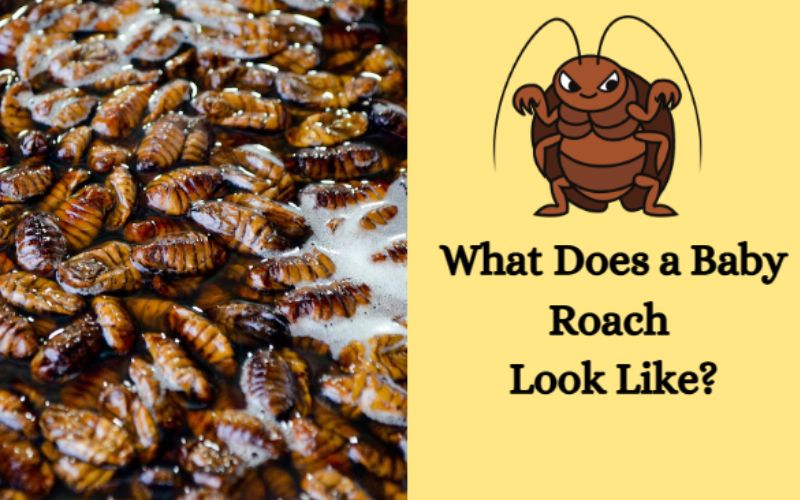You might have seen that little bug in and around your home and often wandering swiftly, which might have made you wonder – what is it? That little bug is a baby roach. You heard it right.
Most of the creatures in the bug family are just as cute as your cuddly pets, but baby roaches? Far from that. It’s not about their appearance, but their presence is quite alarming and creepy to some humans. Imagine the entire race of cockroaches has taken over your home – on your bed, walls, ceilings, kitchen counter, and even curtain – felt something? That’s what we are talking about. A baby roach in your house can cause more trouble than an adult cockroach.
To save you from the dilemma of identifying between your friendly bugs and stinky baby roaches, we have come up with a few pictures of them, and you’ll get your answer to your question – What Do Baby Roaches Look Like?
Baby Roach – What Do They Look Like?
According to the Smithsonian Magazine, there are 4,500 species of cockroaches. Out of which, only 30 are considered pests. Here we will discuss the appearance of these baby cockroaches.
German Baby Roach
These are the tiniest creatures (less than half an inch) among all the baby roaches that invade our homes. They are small in size even when they are adults. However, they are pretty tiny when they are babies (nymphs). When they are born, their head is the size of a pin.
These terrorizing little creatures, as babies, somewhat resemble little beetles. They are white in color when they hatch and turn dark brown with a banded appearance and a light-colored splotch that runs up the middle of their back. They are soft, primarily flat, oval-shaped, dark-colored, and do not have wings.
As they grow up, a parallel black line develops behind their back and changes color from dark brown to blackish. Older nymphs start looking like adult roaches and grow wings when they reach their last stage of growing up. Even as a nymph, their antennae are longer than their body and carry a pair of sensory appendages, also known as cerci.
American Baby Roach
The American baby roach is about one-quarter of an inch and oblong. They have long six spiny legs, thin antennae, and a hard-shelled flattened body, and they also have cerci or appendages at the base of their body.
They can change color from gray to reddish brown and adopt a halo marking behind their back. They are primarily found in sewers and garbage. They hide in your home, where the environment is moist and warm. These American baby roaches cannot fly.
Oriental Baby Roach
Oriental roaches have a fondness for water. Hence, they are also called water bugs. They are about one-quarter of an inch (6 mm) long as a baby and are pale brown in color when they hatch. They do not fly as they do not have wings. These are found mainly in sewers and outdoors. They like living in dark, damp, and semi-cool places. Also, they are pretty similar to American baby roaches.
Brown-Banded Baby Roach
Brown-banded baby roaches are quite small – ⅛ inch only. After they hatch, they have dark-colored heads and light-colored bodies with a banded appearance that broadens at the base.
They also have white bands between their head and midsection. Hence, it makes them easier to identify. They do not have wings, but have yellow and brown color patterns on their bodies. Also, the females are quite smaller than the males.
Smoky Brown Baby Roach
Smoky brown baby roaches are one inch smaller than an adult. They do not have wings and hence, cannot fly. They have white bands that go across the thorax and have whitish-colored antennae or tips. An interesting fact about smoky brown baby roaches is they hold their abdomen above their body and take the appearance of a scorpion. As they grow, they develop wings and are strongly attracted to lights.
Australian Baby Roach
They are very small and do not have wings (just like any other nymphs). They have some yellow splotches that enhance as they enter the later growth stage. As they grow, they develop wings and are good flies.
It is similar to an American baby roach in shape and size. But they are not good swimmers. Also, you’ll find them in moist and cool places.
How Long Does a Baby Roach Stays a Nymph?
Nymph roaches are not exactly cute, cuddly, and sporty as your pets, but learning about their life cycle is fascinating. Did you know that a female American cockroach hatches about 150 nymphs in her entire lifespan? A female German cockroach hatches thousands of roach nymphs in a year.

American Cockroach: An American baby roach changes six to fourteen times and takes 600 days to reach the adult stage.
German Cockroach: As a nymph, a German baby roach sheds its skin six times and takes 103 days to reach adulthood. After their final molt, they grow a pair of wings.
Brown-Banded Cockroach: A brown-banded nymph takes up to 276 days to grow and become an adult. They usually molt up to eight times and are capable of reproducing after their last molt.
Oriental Cockroach: An Oriental nymph takes between 300-800 days to transform into an adult. They are usually active during spring and summer.
What Are the Risks of Having a Baby Roach in the House?
A roach nymph is more dangerous than an adult roach. Though, they both are equally disgusting and carry the same risks of infections. They usually roam around garbage, sewers, kitchen sinks, bathrooms, etc., eating awful things which might disgust your guts. They pick up some bacteria, molds, fungi, and deadly viruses and carry them to our homes.
You might have seen several cockroach nymphs running around the home doing nothing. But actually, they leave a lot of disease-causing bacteria wherever they go. Also, they poop everywhere – on your kitchen top, bed, and even raid your food shelves – though it sometimes goes unrecognized. This might cause food poisoning, asthma, and allergies. Their dropping and skins (sheddings) might become airborne and trigger asthma if you already suffer.
So, if you ever see a baby roach running in and around your home, you can expect a litter of them gathered somewhere in your home. Take proper precautions to get rid of them as soon as possible.
Wrapping Up!
Now that you know how a baby roach looks, identifying and eliminating them will be easier. You must also keep this in mind – if you have found a nymph, then you might also find a few adult cockroaches yet to be manifested. Also, we would love to receive cockroach stories from you in the comment below.
FAQs
Q1. What are the Baby Roaches Called?
Ans. Baby roaches are called nymphs from the time they are born.
Q2. Do Baby Roach Bite?
Ans. Yes. They are capable of biting. However, it is better to maintain a distance from them as their bite could be dangerous, and sometimes lethal.
Q3. Can a Baby Roach Fly?
Ans. When a baby roach is born, they do not develop wings. Hence, they cannot fly until they are adults.
Q4. How Many Babies Can Roaches Have at a Time?
Ans. A brown-banded roach can lay around 18 eggs at a time. Whereas an Oriental and American cockroach can lay around 16 eggs. German roaches can lay 50 eggs at a time.
